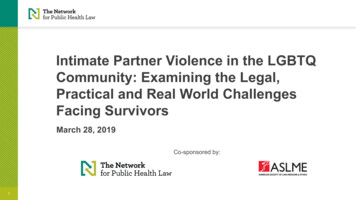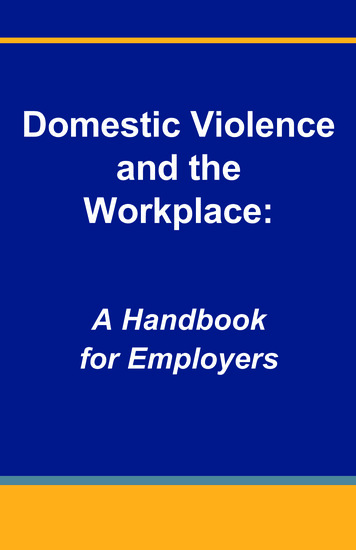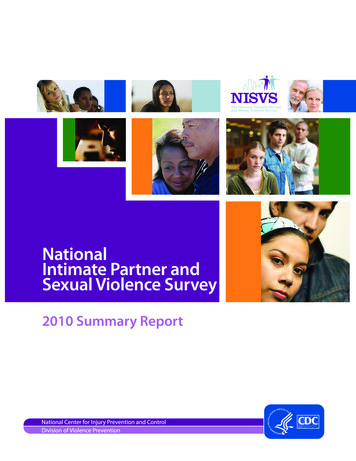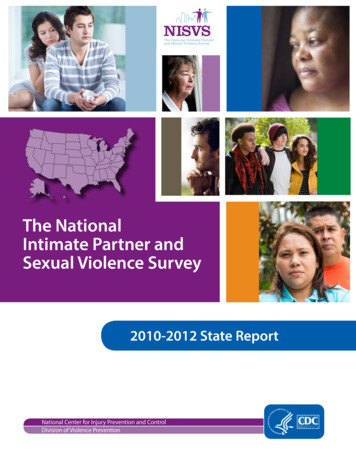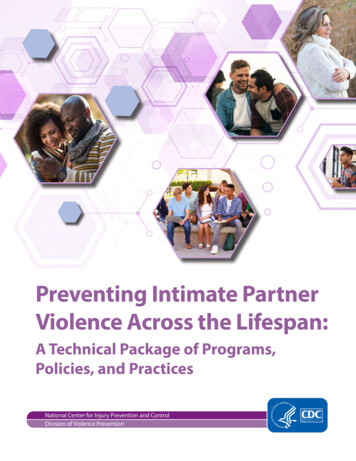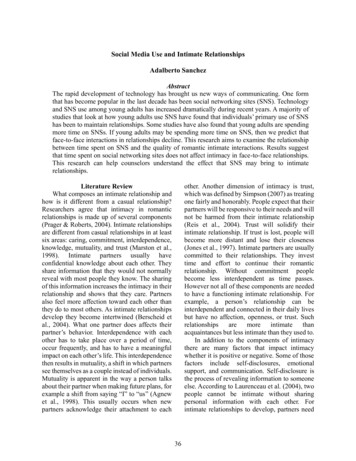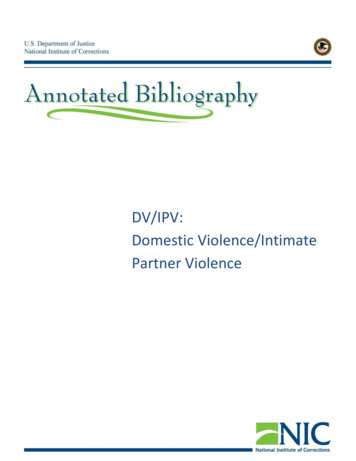
Transcription
Costs of Intimate Partner ViolenceAgainst Women in the United StatesDepartment of Health and Human ServicesCenters for Disease Control and PreventionNational Center for Injury Prevention and ControlAtlanta, GeorgiaMarch 2003
Costs of Intimate Partner Violence Against Women in the United States is a publication of theNational Center for Injury Prevention and Control, part of the Centers for Disease Control andPrevention.Centers for Disease Control and PreventionJulie L. Gerberding, MD, MPHDirectorNational Center for Injury Prevention and ControlSue Binder, MDDirectorDivision of Violence PreventionW. Rodney Hammond, PhDDirectorEtiology and Surveillance BranchIleana Arias, PhDChiefSuggested Citation: National Center for Injury Prevention and Control. Costs of IntimatePartner Violence Against Women in the United States. Atlanta (GA): Centers for Disease Controland Prevention; 2003.
ContributorsThe following individuals contributed to analyses and research efforts thatmade this report possible:Ileana Arias, PhDNational Center for Injury Prevention and Control, CDCRobert Bardwell, PhDBardwell Consulting, Ltd.Eric Finkelstein, PhDResearch Triangle Institute InternationalJacqueline Golding, PhDUniversity of California, San FranciscoSteven Leadbetter, MSNational Center for Injury Prevention and Control, CDCWendy Max, PhDUniversity of California, San FranciscoHoward Pinderhughes, PhDUniversity of California, San FranciscoDorothy Rice, ScD (Hon.)University of California, San FranciscoLinda E. Saltzman, PhDNational Center for Injury Prevention and Control, CDCKevin TateResearch Triangle Institute InternationalNancy Thoennes, PhDCenter for Policy ResearchPatricia Tjaden, PhDCenter for Policy Researchi
Intimate Partner ViolenceAcknowledgmentsWe acknowledge and appreciate the contributions of several CDC colleagues:Sujata Desai, PhD, and Martie Thompson, PhD, for assistance with revisions;Joyce McCurdy, MSA, Melinda Williams, and Chester Pogostin, DVM, MPA,for their coordination efforts; James Mercy, PhD, for scientific review; Marcie-joKresnow, MS, for statistical guidance; Lynda Doll, PhD, for facilitating the externalreview; Phaedra Corso, PhD, for economic consultation; Carole Craft for editing;Alida Knuth and Sandra Emrich for layout and design; and Mary Ann Braun forcover design.In addition, we extend sincere thanks to Sandra N. Howard, Office of the AssistantSecretary for Planning and Evaluation, Department of Health and Human Services,for her valuable comments and oversight; and to Lois Mock, MA, National Instituteof Justice, for coordination efforts.And we gratefully acknowledge our external peer reviewers:Elaine Alpert, MD, MPHBoston University School of Public HealthJens Ludwig, PhDGeorgetown Public Policy InstituteAnne MenardDomestic Violence Resource CenterBrian WiersemaUniversity of Maryland at College Parkii
ContentsCosts of Intimate Partner ViolenceAgainst Women in the United States:Executive Summary1Introduction3Incidence, Prevalence, and Consequences ofIntimate Partner Violence Against Womenin the United States13Costs of Intimate Partner Violencein the United States27Discussion43Appendix ACalculating Lost Productivityand Related Values51Appendix BCalculating Age Group–Specific Present Valueof Lifetime Earnings Estimates55FiguresFigure 1. Percentage Distributions of U.S. Adult Female Victims of IntimatePartner Rape by Medical Care Service Use, 199516Figure 2. Percentage Distributions of U.S. Adult Female Victims of IntimatePartner Physical Assault by Medical Care Service Use, 199517Figure 3. Percentage of Costs of Intimate Partner Violence AgainstU.S. Adult Women by Victimization Type, 199533Figure 4. Percentage of Costs of Intimate Partner Violence AgainstU.S. Adult Women by Cost Type, 199533iii
Intimate Partner ViolenceTablesTable 1.Percentage of NVAWS Respondents and Estimated Number of U.S. Adult WomenNonfatally Victimized by an Intimate Partner in Their Lifetimes and in the Previous12 Months, by Type of Victimization, 199521Table 2.Estimated Number of Nonfatal Intimate Partner Rape, Physical Assault, andStalking Victimizations Against U.S. Adult Women, 199521Table 3.Estimated Victimization Outcomes and Medical Care Service Use by U.S. AdultFemale Victims of Nonfatal Intimate Partner Rape and Physical Assault, 199522Table 4.Estimated Average and Total Number of Medical Care Service Uses by U.S.Adult Female Victims of Nonfatal Intimate Partner Rape and Physical Assault, 199523Table 5.Estimates of Mental Health Care Service Use by U.S. Adult Female Victimsof Intimate Partner Violence by Victimization Type, 199524Table 6.Estimated Percentage of Victims and Number of Nonfatal Victimizations ofIntimate Partner Rape, Physical Assault, and Stalking Against U.S. AdultWomen, by Time Lost from Paid Work and Household Chores, 199525Table 7.Estimated Lost Productivity Among U.S. Adult Female Victims of NonfatalIntimate Partner Violence, by Victimization Type and by Time Lost fromPaid Work and Household Chores, 199526Table 8.Estimated Medical Care Service Use and Unit Costs for Nonfatal IntimatePartner Rape Against U.S. Adult Women, 199536Table 9.Distribution of Primary Source of Payment for Medical Care Resultingfrom Nonfatal Intimate Partner Rape and Physical Assault Against U.S.Adult Women, 199537Table 10. Estimated Medical Care Service Use and Unit Costs for Nonfatal IntimatePartner Physical Assault Against U.S. Adult Women, 199538Table 11. Distribution of Primary Source of Payment for Mental Health Care Resultingfrom Intimate Partner Rape, Physical Assault, and Stalking Against U.S.Adult Women, 199539Table 12. Estimated Total Costs of Intimate Partner Violence Against U.S. AdultWomen, 199540Table 13. Estimated Average Health Care Costs per Nonfatal Intimate Partner Rape,Physical Assault, and Stalking Victimization Against U.S. Adult Women, 199541Table 14. Estimated Lost Productivity Due to Intimate Partner Rape, Physical Assault,and Stalking Against U.S. Adult Women by Victimization Type, 199542iv
Costs of Intimate Partner ViolenceAgainst Women in the United States:Executive SummaryBackgroundAlthough most people believe intimate partner violence (IPV) is a substantial publichealth problem in the United States, few agree on its magnitude. Recognizing the needto better measure both the scope of the problem of IPV as well as resulting economiccosts—in particular, those related to health care—Congress funded the Centers forDisease Control and Prevention (CDC) to conduct a study to obtain national estimatesof the occurrence of IPV-related injuries, to estimate their costs to the health care system,and to recommend strategies to prevent IPV and its consequences.This report— Describes briefly the development of the requested study; Presents findings for the estimated incidence, prevalence, andcosts of nonfatal and fatal IPV; Identifies future research needs; Highlights CDC’s research priorities for IPV prevention.Incidence, Prevalence, and Consequences ofIntimate Partner Violence Against Womenin the United StatesData about nonfatal IPV victimizations and resulting health care service use werecollected through the National Violence Against Women Survey (NVAWS), fundedby the National Institute of Justice and CDC. Based on NVAWS data, an estimated5.3 million IPV victimizations occur among U.S. women ages 18 and older each year.This violence results in nearly 2.0 million injuries, more than 550,000 of which requiremedical attention. In addition, IPV victims also lose a total of nearly 8.0 million days ofpaid work—the equivalent of more than 32,000 full-time jobs—and nearly 5.6 milliondays of household productivity as a result of the violence.Data about IPV homicides were obtained from the Federal Bureau of Investigation’sUniform Crime Reports Supplementary Homicide Reports. According to this source,1,252 women ages 18 and older were killed by an intimate partner in 1995, the sameyear as incidence data reported in the NVAWS.
Intimate Partner ViolenceCosts of Intimate Partner Violence inthe United StatesThe costs of intimate partner rape, physical assault, and stalking exceed 5.8 billion eachyear, nearly 4.1 billion of which is for direct medical and mental health care services.The total costs of IPV also include nearly 0.9 billion in lost productivity from paid workand household chores for victims of nonfatal IPV and 0.9 billion in lifetime earningslost by victims of IPV homicide. The largest proportion of the costs is derived fromphysical assault victimization because that type of IPV is the most prevalent. The largestcomponent of IPV-related costs is health care, which accounts for more than two-thirds ofthe total costs.DiscussionDue to exclusions of several cost components about which data were unavailable orinsufficient (e.g., certain medical services, social services, criminal justice services),the costs presented in this report likely underestimate the problem of IPV in the U.S.Additionally, because of these omissions, the cost figures here are not comprehensiveand should not be used for benefit-cost ratios in analyses of interventions to preventIPV. However, they can be used to calculate the economic cost savings from reducingIPV and associated injuries, to demonstrate the economic magnitude of IPV, and toevaluate the impact of IPV on a specific sub-sector of the economy, such as consumptionof medical resources.More qualitative and quantitative data are needed to better determine the full magnitudeof IPV and associated human and economic costs. There is also a need for primaryprevention—preventing IPV from occurring in the first place—rather than focusing onlyon treating victims and rehabilitating perpetrators after abuse has occurred.CDC, in its Injury Research Agenda, has identified several key areas of research forIPV prevention. These areas include learning how to change social norms that acceptintimate partner violence; developing programs for perpetrators and potential perpe trators; increasing our understanding of how violent behaviors toward intimate partnersdevelop; improving collection of data about IPV and its health effects; developing andevaluating training programs for health professionals; and disseminating strategies thatwork to prevent IPV.Significant resources for research are needed to better understand the causes and riskfactors for IPV and to develop and disseminate effective primary prevention strategies.Until we reduce the incidence of IPV in the United States, we will not reduce the eco nomic and social burden of this problem.2Executive Summary
IntroductionViolence against women is a substantial public health problem in the United States.According to data from the criminal justice system, hospital and medical records, mentalhealth records, social services, and surveys, thousands of women are injured or killedeach year as a result of violence, many by someone they are involved with or wereinvolved with intimately. Nearly one-third of female homicide victims reported in policerecords are killed by an intimate partner(Federal Bureau of Investigation 2001).Intimate partner violence—or IPV—is violence committed by a spouse,ex-spouse, or current or former boyfriend or girlfriend. It occurs amongboth heterosexual and same-sex couplesand is often a repeated offense. Bothmen and women are victims of IPV,but the literature indicates that womenare much more likely than men to sufferphysical, and probably psychological,injuries from IPV (Brush 1990; Gelles1997; Rand and Strom 1997; Rennisonand Welchans 2000).Intimate Partner ViolenceIntimate partner violence—also calleddomestic violence, battering, or spouseabuse—is violence committed by aspouse, ex-spouse, or current or formerboyfriend or girlfriend. It can occuramong heterosexual or same-sex couples.IPV results in physical injury, psychological trauma, and sometimes death (Gelles 1997;Kernic, Wolf and Holt 2000; Rennison and Welchans 2000; Sorenson and Saftlas 1994).The consequences of IPV can last a lifetime. Abused women experience more physicalhealth problems and have a higher occurrence of depression, drug and alcohol abuse,and suicide attempts than do women who are not abused (Golding 1996; Campbell,Sullivan and Davidson 1995; Kessler et al. 1994; Kaslow et al. 1998; Moscicki 1989).They also use health care services more often (Miller, Cohen and Rossman 1993).A growing body of evidence demonstrates the health consequences of intimate partnerviolence against women (Coker, Smith, Bethea, King and McKeown 2000; Kernic,Wolf and Holt 2000). However, the economic costs of IPV remain largely unknown.Previous cost estimates range from 1.7 billion to 10 billion annually (Straus 1986;Gelles and Straus 1990; Meyer 1992), but they are believed to underestimate the trueeconomic impact of this type of violence (Institute for Women’s Policy Research 1995).Researchers have recommended developing national cost estimates for IPV-relatedmedical care, mental health care, police services, social services, and legal services(Gelles and Straus 1990; Straus 1986; Straus and Gelles 1987). However, a recent
Intimate Partner Violenceliterature review (Finlayson, Saltzman, Sheridan and Taylor 1999) found only one U.S.study that derived national cost estimates for violence among intimate partners (Miller,Cohen and Wiersema 1996).Recognizing the need to better measure the magnitude of IPV and resulting economiccosts—in particular, those related to health care—the U.S. Congress funded the Centersfor Disease Control and Prevention (CDC) to conduct a study to obtain national estimatesof the incidence of injuries resulting from IPV, to estimate the costs of injuries to healthcare facilities, and to recommend strategies to reduce IPV-related injuries and associatedcosts. Language related to this funding was included in the Violence Against WomenAct provisions of the Violent Crime Control and Law Enforcement Act of 1994(P.L. 103–322).Given the greater number of IPV-related injuries that occur among women and theinstability of cost estimates based on the small numbers of IPV-related injuries amongmen, this report focuses only on the costs of IPV against women ages 18 and older.Although Congress called only for costs of IPV-related injuries, it was important toinclude the costs of lost productivity resulting from IPV and to determine the economiccosts of lives lost to IPV homicide. These costs contribute significantly to the economicburden of IPV.This report describes the development of the requested study; presents findings for theestimated incidence, prevalence, and costs of IPV among U.S. adult women; identifiesfuture research needs; and highlights some of CDC’s activities related to IPV prevention.The Need to Estimate the Costs ofIntimate Partner ViolenceCost estimates can serve important purposes. For example, they help demonstratethe impact a problem has on society and can shape the attitudes of people who developpublic policy and allocate limited funds (Miller, Cohen and Wiersema 1996; Phillips1987; Snively 1994). They can also help assess the benefit or effectiveness of violenceintervention strategies or programs (Haddix, Teutsch, Shaffer and Dunet 1996; Teutsch1992), which may, in turn, lead to resource allocation to specific programs (Mercy andO’Carroll 1988).The Need for National Estimates ofIntimate Partner ViolenceTo estimate the costs of IPV, one must first estimate its incidence. While most peopleacknowledge IPV as a substantial public health problem, few seem to agree on itsmagnitude (Crowell and Burgess 1996). Several surveys (e.g., Bachman and Saltzman1995; Rennison and Welchans 2000; Straus and Gelles 1990) have attempted to deter mine the extent of violence against women, but methods and findings vary considerably,4Introduction
arousing some debate. Many people contend that the magnitude of violence againstwomen—including violence by intimate partners—is underestimated, while othersbelieve it is exaggerated.Why has the scope of intimate partner violence been so difficult to measure?Lack of consensus about terminology. Researchers have been unable to agree on adefinition of intimate partner violence. In some studies, IPV includes only acts thatmay cause pain or injury, while ignoring behaviors designed to control or intimidate,such as stalking, humiliation, verbal abuse, imprisonment, and denial of access tomoney, shelter, or services.Much of the debate about the number of women affected by intimate partner violenceresults from this lack of consensus. For example, a researcher who defines IPV morebroadly—including stalking and other forms of psychological abuse, as well as physicaland sexual violence—will produce a larger estimate than a researcher who uses a morenarrow definition that includes physical and sexual violence only (DeKeseredy 2000).A definition that separately measures component types of violence—physical, sexual,and emotional—will also likely produce different measurements than one that combinesall types of violence (Gordon 2000).Variations in survey methodology. Sampling strategies and how the purpose of a surveyis explained may affect how participants answer survey questions. For example, a respon dent on the National Crime Victimization Survey may not acknowledge being the victimof IPV if he or she does not believe IPV is a crime. However, the same respondent mightdisclose IPV victimization on a survey about family conflict.Gaps in data collection. Because no national system exists for ongoing collection ofdata about IPV against women, estimates are often drawn from data gathered for otherpurposes. For example, hospitals collect information about victims to provide patientcare and for billing purposes; they may record few details about the violence itself orabout the perpetrator and his or her relationship to the victim. In contrast, police collectdata that will aid in apprehending the perpetrator, and thus may collect little informationabout the victim.Different time frames. Studies of IPV have used different time frames to study victim ization. Some measure lifetime victimization, while others measure annual victimization.These differences are not always well understood and have sometimes resulted in inap propriate comparisons being drawn between studies that are not in fact comparable.Reluctance to report victimization. Many victims do not want to report IPV becausethey may fear, love, depend on, or wish to protect the perpetrator. When medical care isrequired, women may attribute their injuries to other causes.Introduction5
Intimate Partner ViolenceRepetitive nature of IPV. Often, IPV involves repetitive behavior, rather than a singleincident. However, reports about IPV do not always clearly indicate whether data referto the number of IPV incidents or the number of victims.Limited populations. Previous studies have focused either on married or cohabitingcouples or on dating relationships. Although a few studies have looked at violenceamong same-sex couples, most research has examined only heterosexual relationships.Few studies have examined IPV among the population overall.Survey limitations. Many data about IPV have been collected through surveys, whichrely on self-reports by victims. These self-reports may not accurately reflect the magni tude of the problem, if respondents do not answer questions truthfully or do notaccurately recall events. Additionally, despite carefully worded questions and effortsto ensure that participants understand what is being asked, respondents may interpretterms differently.Because methodological differences such as those described here can affect the findingsof a survey or study, researchers must explain the choice of a particular methodology,define terms used, and clearly explain how information was gathered (CDC 2000). Thisinformation allows others to examine findings in the context in which data were collectedand can help readers understand how the findings compare with those of other surveys orstudies. In keeping with this practice, this report specifies the methodology employedand the definitions used.The National Violence Against Women SurveyWhen Congress requested a study about the costs of IPV, no existing survey or study hada large enough sample to reliably estimate the occurrence of IPV-related injuries in theU.S. population. Nor did any existing survey or study include enough information aboutthe nature and extent of injuries and their treatment to make the national projectionsCongress had requested. A new study was needed to fill gaps in knowledge about themagnitude of IPV.Developing and Implementing theNational Violence Against Women SurveyCDC learned that the National Institute of Justice (NIJ), the research arm of the U.S.Department of Justice, had funded Patricia Tjaden and Nancy Thoennes of the Centerfor Policy Research in Denver to develop the National Violence Against WomenSurvey—or NVAWS. The NVAWS was to generate information about the incidence,prevalence, characteristics, and consequences of physical assault, rape, and stalkingperpetrated against U.S. women ages 18 and older by all types of perpetrators,including intimate partners.6Introduction
Rather than duplicating efforts, CDC approached NIJ about supplementing its grant toTjaden and Thoennes to broaden the size and scope of the survey by increasing thesample size, conducting a companion survey of male respondents, and adding questionsabout violence in same-sex intimate relationships. The broader survey could then beused as the basis for calculating more reliable cost estimates of IPV and other forms ofviolence. Both NIJ and the Center for Policy Research agreed to delay the survey toaccommodate a supplemental award and make CDC’s proposed changes.The supplemental funds expanded the survey population to a number large enough toprovide reliable national estimates of the incidence and prevalence of forcible rapes,physical assault, and stalking; related injuries and health care costs, including thosefor mental health care services; and indirect costs due to lost productivity of paid workand household chores.CDC and the office of the Assistant Secretary for Planning and Evaluation, anothercomponent of HHS, contracted with Wendy Max, Dorothy Rice, Jacqueline Golding,and Howard Pinderhughes at the University of California, San Francisco, to use themethodology they had developed earlier (Rice et al. 1996) to review draft survey ques tions and to recommend changes that would enable cost data to be collected with theNVAWS. The survey questions sought to detail the type of violence; the circumstancessurrounding the violence; the relationship between victim and perpetrator; and conse quences to the victim, including injuries sustained, use of medical and mental healthcare services, contact with the criminal justice system, and time lost from usual activities.From November 1995 to May 1996, a national probability sample of 8,000 women and8,000 men ages 18 and older were surveyed via telephone using a computer-assistedinterviewing system. Female interviewers surveyed female respondents. A Spanishlanguage version of the survey was used with Spanish-speaking respondents.In addition to the 8,000 completed interviews, the women’s survey contacts included4,829 ineligible households; 4,608 eligible households that refused to participate; and351 interviews that were terminated before completion. The women’s response ratewas 71.0%.Analyzing NVAWS Data and Estimating the Costs ofIntimate Partner ViolenceTjaden and Thoennes (1999) used the NVAWS data and U.S. Census figures for thepopulation of women ages 18 and older to generate national estimates of the incidenceand prevalence of IPV-related injuries among women.1 Cost estimates were to be derivedfrom these estimates. Max and colleagues (1999) applied their previously developedmethodology for estimating the costs of intimate partner violence to the NVAWS inci dence data and data from other sources (Rice, Max, Golding and Pinderhughes 1996).1This report used only the data about violence committed against women by intimate partners. However,NVAWS data have also provided insight into other areas of violence, including a comparison of women’sand men’s experiences as victims of rape, physical assault, and stalking by all types of perpetrators.Introduction7
Intimate Partner ViolenceCDC funded Research Triangle Institute International (RTI) to derive measures ofreliability for the incidence, prevalence, and cost estimates. Additionally, Max andcolleagues and RTI developed estimates of the present value of lifetime earningsfor fatal IPV by combining economic data with IPV homicide data from the FederalBureau of Investigation.The report that follows reflects CDC’s integration of the work by Tjaden and Thoennes,Max and colleagues, and RTI.Definitions Used in theNVAWS and this ReportThroughout this report, one will read about intimate partner violence (IPV) and specifictypes of violent behaviors, as well as about incidence, prevalence, and victimization ratesof IPV. As stated earlier, there is a lack of consensus about IPV-related terminology.Therefore, it is important to define those terms as they were used in the NVAWS toensure that readers have a consistent understanding of what they mean and to allowreaders to compare findings presented in this report with those of other studies.Intimate partner violence (IPV) against women includes rape, physical assault, andstalking perpetrated by a current or former date, boyfriend, husband, or cohabitingpartner, with cohabiting meaning living together as a couple. Both same-sex andopposite-sex cohabitants are included in the definition. This definition of IPV resemblesthe one developed by CDC (Saltzman et al. 1999); however, it also includes stalkingbecause of the high level of fear that stalking generally provokes in women and theassociated costs that may result.Rape is the use of force, without the victim’s consent, or threat of force to penetrate thevictim’s vagina or anus by penis, tongue, fingers, or object, or the victim’s mouth bypenis. The definition includes both attempted and completed acts. This definition issimilar to that used in the National Women’s Study (National Victim Center and CrimeVictims Research and Treatment Center 1992) and is roughly equivalent to what thejustice system refers to as rape or attempted rape.Physical assault is any behavior that inflicts physical harm or threatens or attempts todo so. Specific behaviors include throwing something at the victim; pushing, grabbing,or shoving; pulling hair; slapping, hitting, kicking, or biting; choking or trying to drown;hitting with an object; beating up the victim; threatening with a gun or knife; and shoot ing or stabbing the victim. This definition is similar to that used in the National FamilyViolence Survey (Straus and Gelles 1986) and the Canadian Violence Against WomenSurvey (Johnson 1996), and it is roughly equivalent to what the justice system refers toas simple and aggravated assault.8Introduction
Stalking is repeated visual or physical proximity, non-consensual communication, and/orverbal, written, or implied threats directed at a specific individual that would arouse fearin a reasonable person. The stalker need not make a credible threat of violence against thevictim, but the victim must experience a high level of fear or feel that they or someoneclose to them will be harmed or killed by the stalker. This definition is similar to thatused in the model anti-stalking legislation developed for states by NIJ (National CriminalJustice Association 1993).Prevalence is the number of U.S. women ages 18 and older who have been victimized byan intimate partner at some point during their lifetimes (lifetime prevalence) or during the12 months preceding the NVAWS (past 12 months prevalence). In this report, prevalencerefers to past 12 months prevalence unless otherwise specified.Incidence is the number of separate episodes of IPV that occurred among U.S. womenages 18 and older during the 12 months preceding the survey. For IPV, incidencefrequently exceeds prevalence because IPV is often repeated. In other words, onevictim (who is counted once under the prevalence definition) may experience severalvictimizations over the course of 12 months (each of which contributes to the incidencecount).Victimization rate is the number of IPV victimizations involving U.S. women ages18 and older per 1,000 women in that population. The population estimate used in thisreport is the U.S. Census Bureau’s projection of 100,697,000 women ages 18 and olderin 1995.A Note About Annual EstimatesThis report presents annual data about IPV and its costs, generalized from data aboutthe incidence of intimate partner violence in a given year (1995) and the costs associatedwith those victimizations. CDC acknowledges that the health care costs, value of lostproductivity, and present value of lifetime earnings among IPV murder victims may bedifferent today than in 1995. However, this report reflects the most appropriate, reliabledata currently available about the costs associated with IPV.Introduction9
Intimate Partner ViolenceReferencesBachman R, Saltzman L. Violence Against Women: Estimates From the RedesignedSurvey. U.S. Department of Justice, Bureau of Justice Statistics, NCJ 154348; 1995.Brush LD. Violent acts and injurious outcomes in married couples: methodologicalissues in the National Survey of Families and Households. Gender and Society1990;4(1):56–67.Campbell J, Sullivan CM, Davidson WD. Women who use domestic violence shelters:changes in depression over time. Psychology of Women Quarterly 1995;19:237–55.Centers for Disease Control and Prevention. Building data systems for monitoring andresponding to violence against women: recommendations from a workshop. Morbidityand Mortality Weekly Report 2000;49(RR-11):1–16.Coker AL, Smith PH, Bethea L, King MR, McKeown R
March 2003. Costs of Intimate Partner Violence Against Women in the United States is a publication of the . Steven Leadbetter, MS . National Center for Injury Prevention and Control, CDC . Wendy Max, PhD . University of California, San Francisco . Howard Pinderhughes, PhD .


